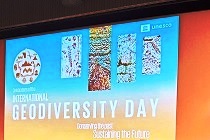 On 7 October 2024, a conference was held at UNESCO's headquarters in Paris to celebrate the International Day for Biological Diversity.
On 7 October 2024, a conference was held at UNESCO's headquarters in Paris to celebrate the International Day for Biological Diversity.

Prof. Stanislaw Wolkowicz at the UNESCO conference
The initiators of this idea were four eminent professors: José Brilha (Portugal), Murray Gray and Jack Matthews (UK) and Zbigniew Zwoliński (Adam Mickiewicz University in Poznań, Poland). They started their efforts to establish such a day in 2020, and already on 23 October 2021, during the 41st Session of the UNESCO General Conference, it was agreed that from 2022 onwards, 6 October would be an annual International Day for Biological Diversity. In keeping with this rather short tradition, UNESCO is organising a commemorative conference at which representatives of the initiating countries deliver papers. This year, Kazakhstan was invited to co-organise the conference, and additionally, at the invitation of Özlem Adiyaman Lopes, Ph.D. (UNESCO), Prof. Stanislaw Wolkowicz (PGI-NRI) participated in it.
Moderated by Kristof Vanderberghe, Chief of the Section for Earth Sciences and Geo-Hazard Risk Reduction, the conference began with speeches by ambassadors of the International Day for Biological Diversity initiative countries. Ambassador Mariusz Lewicki, Permanent Representative of the Republic of Poland to UNESCO in Paris, spoke on behalf of Poland.
Later in the conference, four papers were given by representatives from the UK, Portugal and Poland. Prof. Zbigniew Zwoliński (Adam Mickiewicz University in Poznań) in his lecture entitled ‘Designing a new geodiversity assessment standard’ presented a new method of assessing geodiversity of objects, illustrating it with examples from north-western Poland.
The representative of PGI-NRI, Prof. Stanislaw Wołkowicz, as previously agreed with PhD Özlem Adiyaman Lopes, gave a paper entitled ‘Conservation of geodiversity in Africa: support of the Polish Geological Institute through participation in the PanAfGeo Project’. Africa is a vast continent whose geodiversity is described in many articles and monographs. Extremely interesting sites are visited by large numbers of tourists, yet there are only two geoparks of UNESCO rank on this continent: Ngorongoro - Lengai in Tanzania and M'Goun in Morocco. In comparison, there are 17 such geoparks in Spain!

Speech by Prof. Stanisław Wołkowicz (first on the right)
Prof. Stanisław Wołkowicz, who is the leader of the New Frontiers in Geosciences: Geoheritage and Geothermal Energy Working Group in Phase 2 of the PanAfGeo Project, discussed PGI-NRI's activities in Africa in the field of geological heritage conservation. Three trainings were organised between 2022 and 2024: in Pointe Noire (Republic of Congo, in French), in Lubango (Angola, in Portuguese) and in Lobatse (Botswana, in English). These trainings were attended by 66 participants, including 31 women and 35 men. They represented 31 African countries and were selected from 312 people who sent their applications. In addition, 10 persons delegated by UNESCO National Committees participated in the trainings.
As can be seen from this, the problem of geodiversity conservation is recognised by the African Geological Surveys, which are the institutions that should initiate the process of preparing the documentation for the establishment of a geopark, from the local or regional scale, through geoparks of national rank to the global rank accepted by UNESCO. Stanislaw Wołkowicz said that during the training sessions conducted, theoretical knowledge was imparted, including the applicable legal regulations recommended by UNESCO and in force in European countries, and then during field practice the trainees described the selected geostations and valorised them on the basis of unified international forms.
The official part of the International Day for Biological Diversity was followed by a walk through the main UNESCO building, where on one of the walls a large ‘abakan’ (a type of artistic fabric that is a monumental spatial composition similar to a sculpture, designed by the Polish artist Magdalena Abakanowicz) can be admired. The discovery of the evening was that the Ambassador of Kazakhstan, Askar Abdrakhmanov, speaks excellent Polish.
Text: Stanisław Wołkowicz














 PGI-NRI offer
PGI-NRI offer Mineral resources of Poland
Mineral resources of Poland  Oil and Gas in Poland
Oil and Gas in Poland 




 Subscribe to RSS Feed
Subscribe to RSS Feed